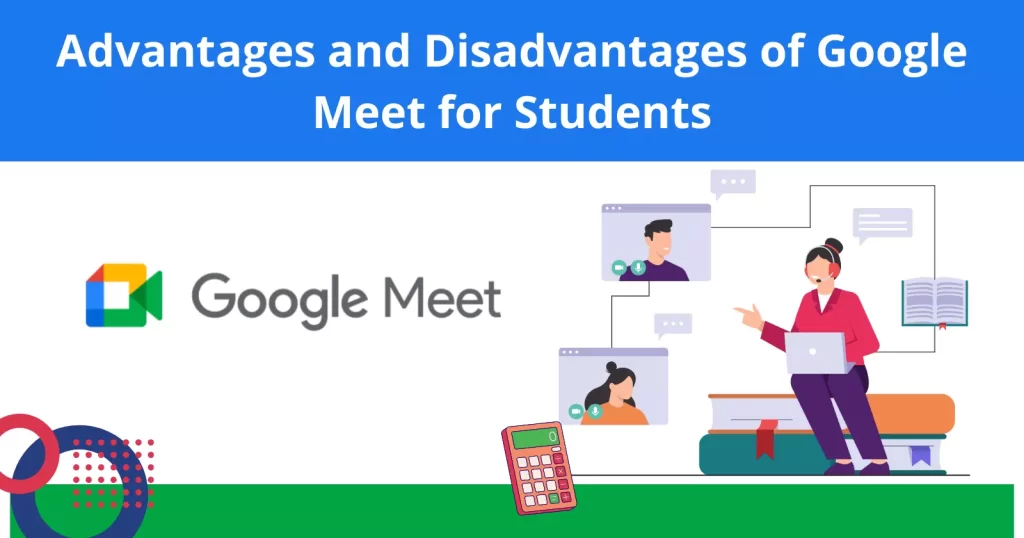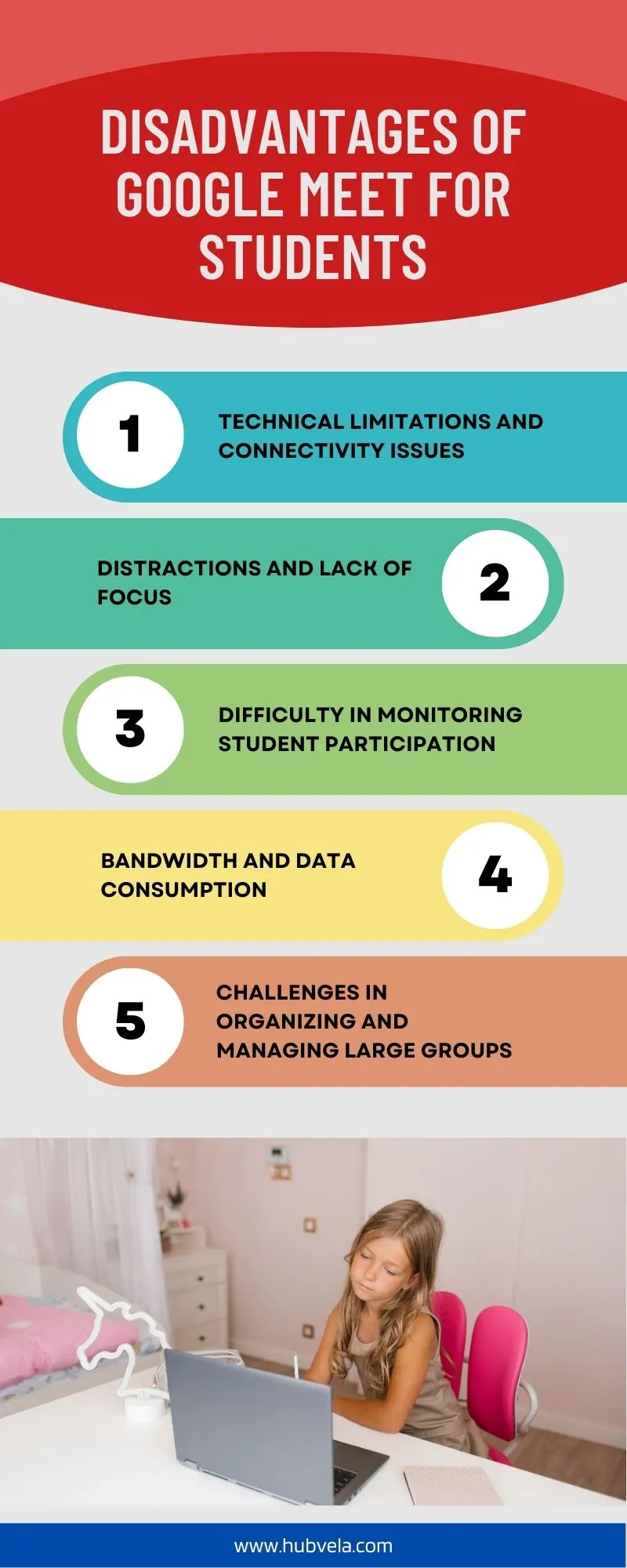Google Meet is a video conferencing platform that has become increasingly popular among students and educators alike, especially during the COVID-19 pandemic. It is a tool that allows for remote communication and collaboration, making it an essential part of the modern classroom.
However, like any other technology, Google Meet has its advantages and disadvantages. In this article, we will explore the pros and cons of Google Meet for students, highlighting its benefits and limitations.

--Advertisement--
Advantages of Google Meet for Students
Google Meet has become an essential tool for remote learning, allowing students and teachers to connect and collaborate from any location. With its easy-to-use interface and advanced features, Google Meet has quickly become a popular choice for educators and students alike. We will explore the advantages of Google Meet for students.

1. Seamless Virtual Classroom Experience
Google Meet provides a seamless virtual classroom experience for students. With easy-to-use, reliable, and secure video conferencing, Meet integrates seamlessly with other Google products like Classroom, Slides, Docs, and Gmail.
It is user-friendly and can introduce students to new communication methods. Virtual classrooms are the future of online learning, and Google Meet is a great tool for this purpose.
Seamless third-party integration allows knowledge providers to leverage the existing system and expand its use for students’ benefit. If you already use Google Classroom, teaching online with Google Meet should be pretty seamless.
Google Meet is available for G Suite users (in education, business, etc.), and it’s a quick, easy way to connect with your students via live video. Google Classroom’s video conference application Meet is being used 25 times to enhance the learning experience of students, according to the teachers’ perspective.
2. Integration with Google Workspace
Google Meet is a video conferencing tool that is part of Google Workspace for Education. It has many advantages for students, including easy-to-join video calls that let you host meetings on the go from any location or device.
In addition, depending on your Google Workspace version, you can host up to 250 attendees. Google Meet integrates seamlessly with other products like Classroom, Slides, Docs, and Gmail.
This integration with Google Workspace is a significant advantage for students as it allows them to easily access and share their assignments, class activities, and other educational resources with their teachers and classmates. Moreover, Google Meet is more secure, easy to use, and engaging.
It has advanced features like breakout rooms, live streaming, attendance tracking, Q&A, polls, and more that can enrich teaching and learning. These features can benefit both students and teachers by making remote learning more interactive and engaging.
3. Screen Sharing and Presentation Tools
Screen sharing and presentation tools are some of the advantages of Google Meet for students. With Google Meet, screen sharing is simple; students can tap “present now” and select whether to share the entire screen or just a window.
This feature can be helpful for students who need to share their work with their classmates or teachers during online classes. Additionally, Google Meet is easy to use and can be accessed from any location or device, which can save students time.
Furthermore, Google Meet integrates seamlessly with other products like Classroom, Slides, Docs, and Gmail, making it easier for students to access their work and collaborate with their classmates.
4. Real-time Chat and Messaging Features
Real-time chat and messaging features are some of the advantages of Google Meet for students. Google Meet allows students to communicate with their teachers and classmates in real time, which can be especially helpful for remote learning.
Students can use the chat feature to ask questions, share ideas, and collaborate on projects. Additionally, Google Meet offers a digital whiteboard called Google Jamboard, which can be used for collaborative brainstorming sessions.
The platform also offers features such as attendance reports, breakout rooms, and polling, which can enhance the learning experience. Another advantage of Google Meet is that it is relatively easy to use, and joining a meeting is as simple as clicking or tapping a link.
The platform is also available via a web app or a dedicated native app for various operating systems. However, it is important to note that the quality of the user experience still depends on the hardware capabilities of a particular device.
5. Cross-platform Compatibility and Mobile Accessibility
One of the advantages of Google Meet is its cross-platform compatibility and mobile accessibility.
Google Meet allows for easy-to-join video calls that can be hosted from any location or device. This means that students can participate in virtual classes from their smartphones, tablets, or laptops, regardless of their operating system.
In addition, Google Meet is included in Google Workspace for Education, which integrates seamlessly with other Google products like Classroom, Slides, Docs, and Gmail, as stated on the website.
This makes it easy for students to access virtual classes and other educational resources from a single platform.
Moreover, Google Meet is more secure, easy to use, and engaging. Google Meet is designed to be secure by default, and meetings initiated from Google Classroom will soon be safer and more secure by design.
Every teacher and co-teacher in a Classroom class will be meeting hosts in Meet by default, so multiple teachers can share the load of managing a class.
Overall, Google Meet’s cross-platform compatibility and mobile accessibility make it a convenient and flexible tool for students to participate in virtual classes from any location or device.
Disadvantages of Google Meet for Students
Google Meet has become a popular video conferencing tool for students and educators alike. However, like any software, it has its limitations. We will explore the disadvantages of Google Meet for students.

1. Technical Limitations and Connectivity Issues
Technical limitations and connectivity issues are some of the major disadvantages of Google Meet for students. Students may experience poor video quality, trouble joining meetings, or other performance issues if Meet is unavailable.
In addition, technical or network issues can cause Google Meet to drop some members from a meeting, especially those attended by a large number of participants.
Moreover, to use Google Meet, students need a dual-core processor, 2GB memory, and a strong internet connection.
Devices with outdated processors and RAM may find it difficult to run a video conference due to the large number of hardware resources that Google Meet uses.
Furthermore, Google Meet lacks particular features catered by its competitors, and sometimes, the browser may freeze while sharing the screen.
To avoid some of these issues, students can try to close any open browser tabs, windows, or apps that aren’t currently being used, turn off any Chrome extensions, especially Meet-specific ones, and ensure that they have a strong internet connection.
2. Distractions and Lack of Focus
Distractions and lack of focus are common issues for students during online classes, including those held on Google Meet. Students have to contend with distractions, especially when they are at home, where they are not in a classroom setting dedicated to learning.
It is easier to daydream or get caught up in other thoughts when there isn’t a teacher in the room to bring the class to attention. Additionally, the pandemic has added an entirely new set of mental distractions.
One of the biggest distractions is online distractions. Students may keep several windows open so that they can check email and chat with friends while the class may be in session.
To address this issue, Google Meet provides accessibility features that allow users to focus their meeting view on just the presenter or hide participants with video feeds they find distracting.
Students can also eliminate extra screens and devices, track and reduce their clicks, and schedule breaks to stay focused during virtual meetings. However, students still feel that technology is necessary when the classes are not engaging enough.
Therefore, teachers and instructors should make their classes more engaging to reduce distractions and increase students’ focus.
3. Difficulty in Monitoring Student Participation
One of the disadvantages of Google Meet for students is the difficulty in monitoring student participation. While presenting, it can be challenging to see all students at once.
Although attendance tracking is available for some Google Workspace users, it is only retained for a short time and may not be accessible to all users.
The Meet Quality Tool can assist in troubleshooting, but it is not designed for monitoring student participation. This can make it difficult for teachers to stay connected to their students, assess their understanding, monitor their engagement, and take questions.
4. Bandwidth and Data Consumption
Bandwidth and data consumption are significant disadvantages of Google Meet for students. Google Meet’s users can spend at least 2.6 GB of data per hour in HD (720p) video quality settings.
It means, using Google Meet at SD quality (480p) can consume 0.9 GB of internet quota every hour. These estimations can be bigger because the duration of online meetings or learning usually reaches several hours each day.
This can be especially constraining on mobile networks, where data caps are common. However, there are ways to reduce data usage in Google Meet.
Google Meet has added a ‘limit data usage’ setting for Android and iOS users, which allows users to optimize video call quality for their device and network conditions.
5. Challenges in Organizing and Managing Large Groups
Challenges in Organizing and Managing Large Groups can be a significant disadvantage of Google Meet for students. Meeting face-to-face as a group is an ideal way to team-build, and it allows remote employees the chance to get to know each other beyond their job roles.
However, virtual meetings can make it challenging to build relationships and establish a sense of community. Administrators can control the Google Meet features teachers and students can use, but it can be difficult to ensure that students don’t share accounts or limit Meet bandwidth.
Technical difficulties, lack of clarity or purpose, and meeting length are some of the meeting challenges that people most often face in meetings. To overcome these challenges, it is essential to keep the focus of the meeting, send an agenda in advance, and encourage attendees to prepare and add to the discussion.
District IT admins can review their Meet admin configuration to avoid many common remote learning issues, such as preventing students from joining a Meet call before the teacher, starting a Google Meet call, or re-using a Meet link after the teacher has left.
Conclusion on the Advantages and Disadvantages of Google Meet for Students
In conclusion, Google Meet has both advantages and disadvantages for students. One of the main advantages is that it is relatively easy to use, with joining a meeting being as simple as clicking or tapping a link.
Additionally, it allows for virtual meetings with up to 100 people simultaneously for as long as needed. However, one of the main disadvantages is that it consumes a considerable amount of hardware resources, making it difficult for devices with outdated processors and random access memory to run a video conference.
Another disadvantage is that it lacks certain features that are offered by its competitors. Despite these drawbacks, Google Meet remains a popular video conferencing platform for remote learning and communication.


